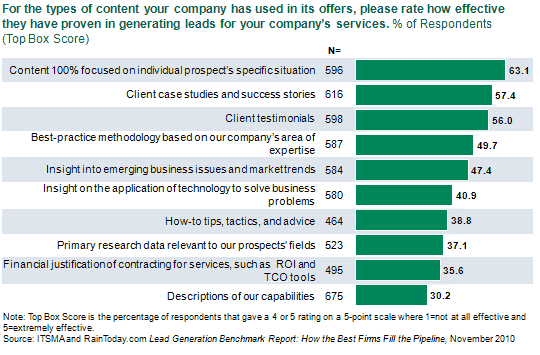Don’t get me wrong, I’m as much into capitalism as the next person, but it seems our collective drive for business dominance has painted marketing into a corner. In an attempt to get our messages heard, we’ve created an annoying disturbance of white noise, forcing our prospective clients to tune us out while finding answers the old-fashion way: they search for them.
Enter content marketing, the art of strategically placing valuable content where solution seekers search. Doing it right is not as simple as it seems, but if you keep these four principles in mind, you too can get your message found, while strengthening lead flow and elevating your company’s status to that of “Trusted Advisor.”
Principle 1: Commit to Content Marketing
Shifting the mentality to content marketing can be tough. For starters, extracting and crafting valuable content from organizations new to content marketing is extremely difficult. You have to transform from marketer, shooting the speeds and feeds of an offering, to a publisher, providing valuable guidance with an editorial perspective. Keep these three simple rules in mind:
- What do you want the reader to do? Each piece must have a purpose. Know how the editorial will naturally progress a buyer further along the buying continuum.
- Make sure the content has relevant substance (see Principle 2 below). Searchers aren't looking for bones, they're looking for meat.
- Customized content isn’t a “nice to have,” it’s a “must have.” You won’t be totally relevant if you don’t target buyer types with the right content.
Principle 2: Relevant Content is Valuable Content
The IT Services Marketing Association (ITSMA) recently released a study providing insight into the research behaviors of IT buyers. They’ve proven once again that the most relevant content should describe the impact of a solution on specific cases. Your editorial content should be packed with proof points, testimonials and case studies.
If you're not in the business of providing IT solutions, don't assume this data representative of your target audience.
Principle 3: Evolve Your Content as Your Prospect Evolves
In the buying cycle, prospects move from one decision stage to the next in a natural evolution toward purchase, so content should evolve with the buyer by driving home the message appropriate to each stage. For example, in the awareness stage you should be helping buyers understand the problem with "status quo," while in the decision stage you should be validating your method of solving their problem.
How do you make your content decision-stage appropriate?
Begin with research. Develop in-depth knowledge of the target audiences, their challenges and their unique, emotional hot buttons. Start by positioning the problem or opportunity, create urgency for change, provide third-party research to support your story, then validate your solution with real-world examples.
Keep your campaign straight by segmenting the audience and tuning content for each buyer type. Use an automated marketing system to stage editorials for buyer consumption. And finally, remember to re-purpose your content to support consumption across a variety of content networks, i.e. web, social media, print, etc.
Principle 4: Syndicate Smartly
When it comes to publishing your content, you should be taking a broad look at all the possibilities. Where do your ideal buyers consume information? More and more, the Internet is where many of them research, but don’t assume it will be adequate in all cases. Look into association newsletters, trade publications and industry periodicals. Online vehicles should include search engine pay-per-click (PPL), industry information portals, syndication networks and partner websites. Don’t forget to incorporate syndication methods on your own website. Really Simple Syndication (RSS) lets prospects subscribe to automatic content feeds. And thanks to technology mashups, pushing content into the social media realm of Twitter, Facebook and LinkedIn has never been easier.
I hope this gives you a good foundation for content marketing. Connecting with your buyer can be challenging these days, but by truly investing in content marketing, you will position yourself as a trusted source, and see stronger lead flow and velocity in your sales pipeline.
Drop me a comment on how you’ve learned to elevate your message above the noise.







